The appeal of peelable resist technology.
Peelable resist technology and its use in the manufacturing of printed circuit boards can be traced back at least three decades. It was used as selective plating resists, as well as solder resists. The development of hot air solder leveling (HASL) in the early 1980s necessitated technical improvements in peelable technology that enabled these systems to withstand the new demands of the HASL process. The wheel now appears to have turned full circle, and manufacturers of peelable resists have had to review the current level of technology in order to meet the increased demands that lead-free soldering has placed upon these peelable resists. In addition to the new technical demands, raw material health and safety issues will also impact manufacturers.
Peelable resists belong to a general category of coatings known as plastisols. These coatings are essentially stable dispersions of powdered PVC resin in a continuous or liquid phase. PVC resins have what is called a linear isotactic structure, the chlorine is always on the same side of the carbon atom, causing crystallization within the PVC polymer. Because this limits the solubility in most common organic solvents, PVC resin is incorporated into the plastisol in a solid or disperse phase. The resin is then dispersed uniformly into what is known as a plasticiser (the liquid continuous phase). The peelable coating is essentially solvent-free with the plasticiser basically forming part of the final, fused film after thermal cure. The choice of both PVC resin and plasticiser types, coupled to the optimal ratio between the two, is critical to the overall performance (solder resistance and peelability) of the coating.
Upon thermal curing, the plasticiser is essentially absorbed into the PVC resin to produce a high-build, tough, flexible, chemically resistant film that has excellent cohesive strength but minimal adhesion to the substrate. Hence it is peelable!
The Lead-Free Challenge
All lead-free alloys have higher melting points than those of eutectic solder, resulting in the soldering temperatures being approximately 30ºC higher. At this increased temperature, many peelable resists lose their usual flexibility and become hard and brittle– and very difficult to remove.
FIGURE 1 illustrates what can happen to a standard peelable film when subjected to multiple, high-temperature, lead-free soldering processes. Note the changes in the portion of the film actually soldered. The film matrix has shrunk and the film has badly discolored. Film flexibility and peelability were lost.
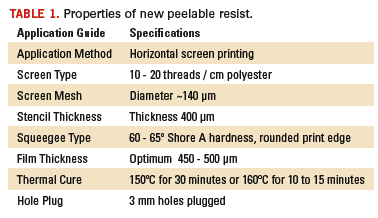
New Product Development
Taking into consideration the above challenge, a project to develop a new peelable resist product that would meet these new goals was undertaken. It had the following objectives: to produce a final product capable of resisting multiple high-temperature soldering processes, as seen with lead-free alloys, and to only use raw materials that did not compromise health and safety directives and regulations.
With the initial development work now complete, the new product has been given a thorough testing with numerous PCB customers and assemblers, using both multiple eutectic soldering processes and lead-free alloys. Results thus far show the new system to be compatible to both eutectic soldering and to the more aggressive lead-free soldering processes. The initial product data can be found in TABLE 1.
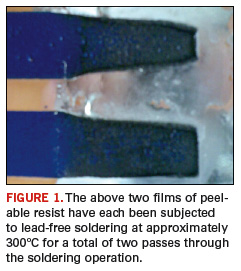
To those who use peelable coating, much of the above data would be considered standard. The essence to a successful peelable coating is found not only in the formulation, but also in the processing, where a thick film that has excellent cohesive strength, yet remains soft enough to be easily removed, is key. The coating and the application parameters must be such to allow the film to be applied over the circuit board, encapsulating all necessary areas including the plugging of plated holes. In this latter respect, the rheology (or more loosely called structure) of the product is all-important. The rheology of the peelable must allow for ease of application of a thick film– but without any film slumping or sagging or thinning of the film over the plugged hole. The formulator’s art is in obtaining excellent printing properties along with equally excellent hole plugging without any sagging or additional flow of the freshly applied film. FIGURE 2 gives the rheology curve of such a coating.
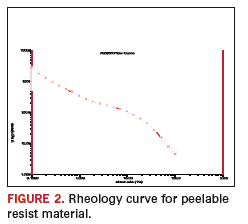
The vertical axis refers to viscosity, whereas the horizontal axis refers to shear rate. The coating was placed on a rheometer, and a progressive stress was placed upon the coating. The resulting rheology curve (seen here as the red line) shows what happens to the film at different shear rates or with increasing strain. Under low-stress conditions, or gravitational forces, the coating exhibits a very high viscosity (refer to the red line on the left of the graph). As shear rate or stress is increasingly applied (with either mixing or screen printing), the viscosity is progressively lowered, and the coating becomes thinner and more liquid. However, take the source of shear or stress away, and the viscosity of the coating will return to its original high value. This loss in viscosity, or “structure,” is common with many liquid coating systems (solder mask, etch resists, etc.), but it is an important property with peelable coatings, as it will define the ability of a particular product to be successfully printed into plated holes without any thinning of the film around the barrels of the holes. FIGURES 3, 4 and 5 show these properties of the coating. In these examples, the coatings have been subjected to a lead-free hot air level process first.
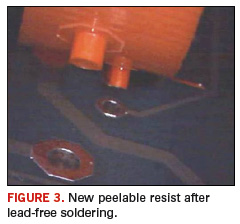
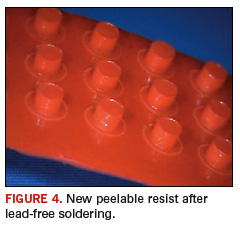
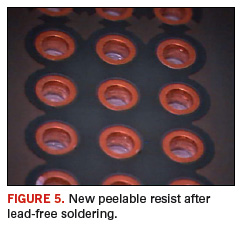
Figure 1 showed the result of an existing peelable system that had been subjected to a double pass through a lead-free soldering operation at 300º C. FIGURE 6 shows the new peelable system after it has been subjected to one hot air level and two wave solder processes using lead-free alloys.
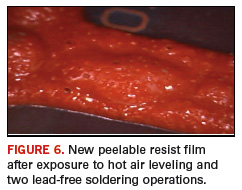
This paper has sought to outline the challenge that lead-free alloys have brought to the area of peelable resist technology. To meet these challenges, coatings manufacturers need to address not only the technological hurdles, but also to keep in mind the current health and safety constraints that are placed on raw materials. New materials that are acceptable for use are combined with the added expertise of the formulators to produce a final product that can perform at new lead-free soldering temperatures. PCD&F
Ian Mcdonald is an international technical sales support executive with Sun Chemical and can be reached at This email address is being protected from spambots. You need JavaScript enabled to view it..
ACKNOWLEDGEMENTS
The author would like to thank all the technical personnel in the Circuits Research and Development laboratory at MSN (England) without whose help and advice this paper could not have been written.




















